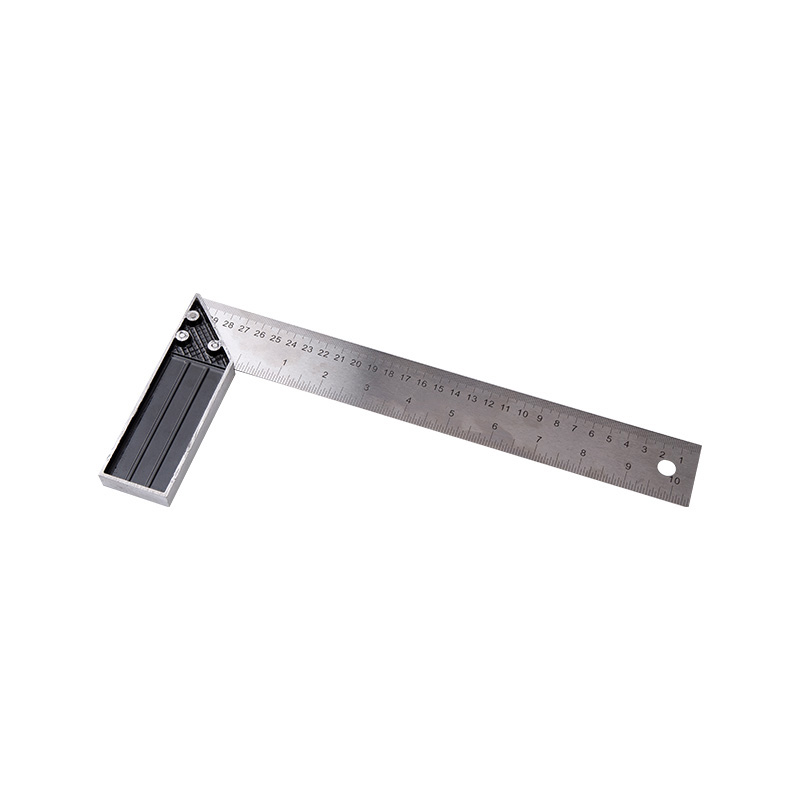When selecting a high-quality try square for professional use, consider the following features:
1.Material: Opt for a try square crafted from high-quality materials such as hardened steel or anodized aluminum. These materials offer exceptional durability and resist wear, ensuring longevity and consistent performance in professional settings.
2.Accuracy and Calibration: Precision is paramount in professional woodworking. Prioritize try squares that undergo rigorous calibration processes to guarantee perfect squareness. Accurate markings and etchings on the blade facilitate precise measurements, minimizing errors in intricate woodworking tasks.
3.Finish and Rust Resistance: A flawlessly polished finish on both the blade and handle not only enhances aesthetics but also prevents rust and corrosion. A rust-resistant try square is essential for maintaining accuracy over time and ensures smooth operation during tasks.
4.Handle Design and Ergonomics: Evaluate the handle design for ergonomic comfort. A well-designed handle allows for a secure grip, reducing hand fatigue during prolonged use. Consider models with cushioned or contoured handles, providing a comfortable grip and precise control over measurements.
5.Visibility of Markings: Clear, deeply-etched markings on the blade enhance visibility, allowing woodworkers to read measurements accurately from various angles. Dual markings on both sides of the blade further enhance visibility, ensuring versatility in applications.
6.Blade Thickness and Stability: Thicker blades provide stability and reduce the risk of warping, ensuring the try square maintains its accuracy over time. Thick blades are less susceptible to bending, providing reliable reference edges for precise measurements and markings.
7.Blade Length and Versatility: Choose an appropriate blade length based on the scope of your projects. Longer blades are ideal for larger materials, facilitating extended markings with stability. Shorter blades offer enhanced precision for intricate tasks and smaller pieces, allowing detailed measurements with ease.
8.Sharpness and Edge Quality: A sharp and well-defined edge is crucial for accurate marking and measuring. High-quality try squares feature finely honed edges that effortlessly glide across the surface, ensuring clean and precise markings without damaging the workpiece.
9.Balance and Weight Distribution: A well-balanced try square with an evenly distributed weight ensures stability during measurements. Balanced tools are easier to handle, allowing woodworkers to maintain accuracy without strain, particularly in delicate or complex woodworking applications.
10.Ease of Adjustment and Locking Mechanism: If the try square features an adjustable blade, assess the adjustment mechanism. Smooth and precise adjustments, coupled with a reliable locking mechanism, enable woodworkers to set and secure angles effortlessly, enhancing efficiency and accuracy in measurements.
11.Visibility of the 90-Degree Angle: The junction where the blade meets the handle should form a perfect 90-degree angle. This angle serves as the fundamental reference point for squareness. Ensure this angle is meticulously crafted and clearly visible, allowing woodworkers to align the tool accurately.
12.Brand Reputation and Reviews: Research reputable brands known for their precision tools. Explore professional reviews and testimonials from experienced woodworkers to gauge the tool's performance, durability, and accuracy in real-world applications.
13.Warranty and Customer Support: Consider the manufacturer's warranty and the availability of dedicated customer support services. A comprehensive warranty demonstrates the manufacturer's confidence in their product, providing assurance to professionals. Reliable customer support ensures assistance in case of issues or inquiries, enhancing the overall user experience.
Aluminium handle try square


